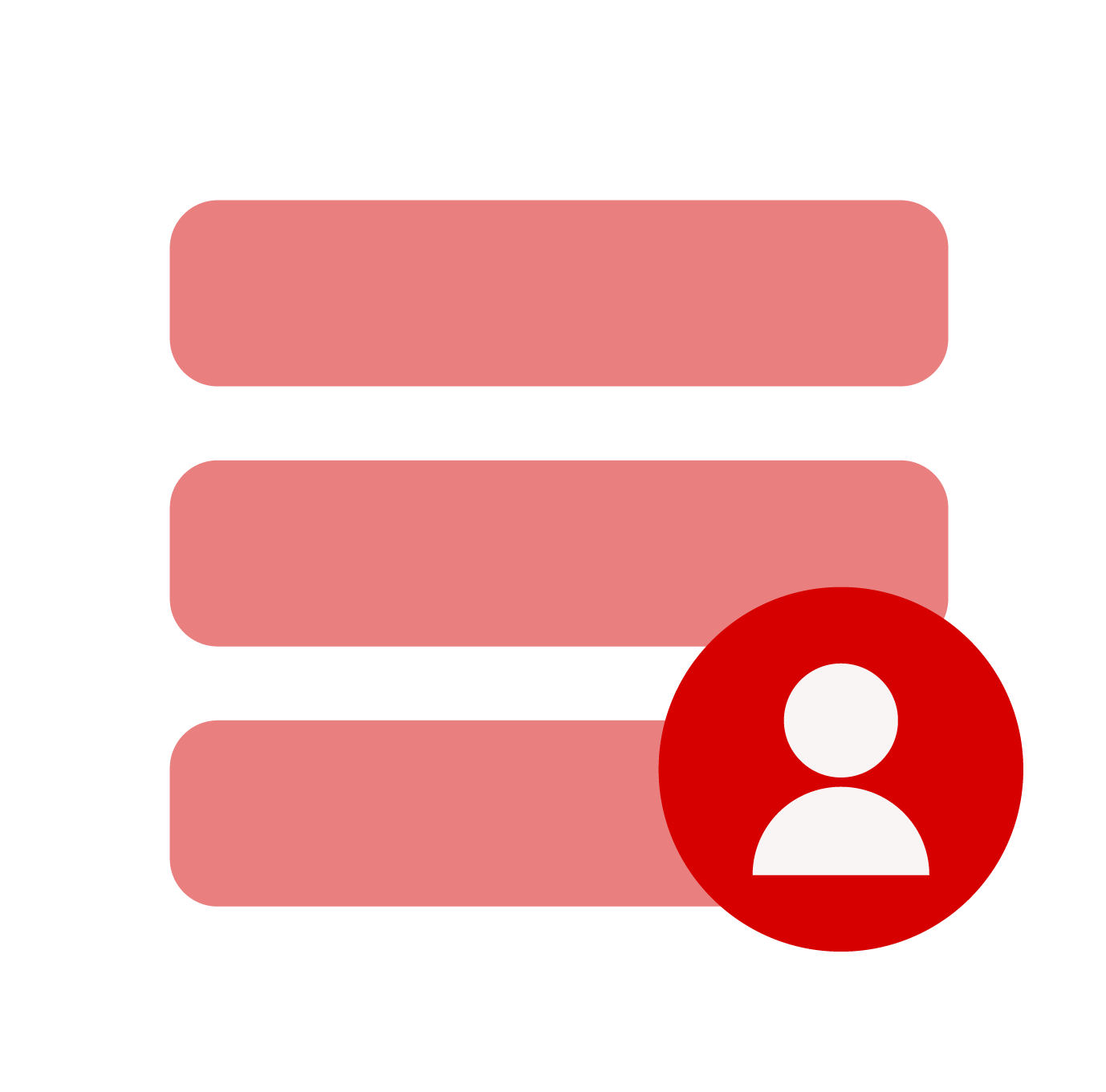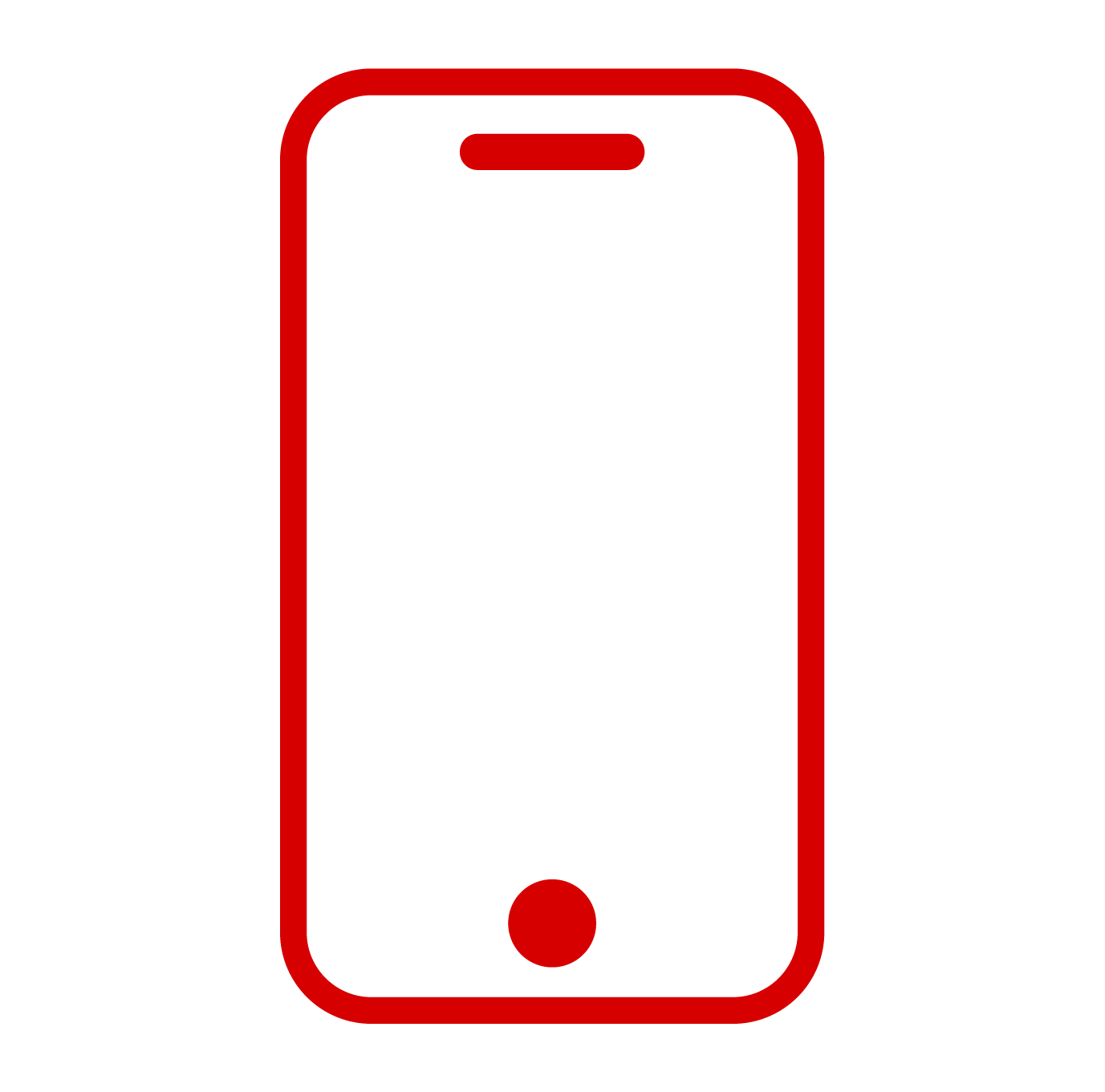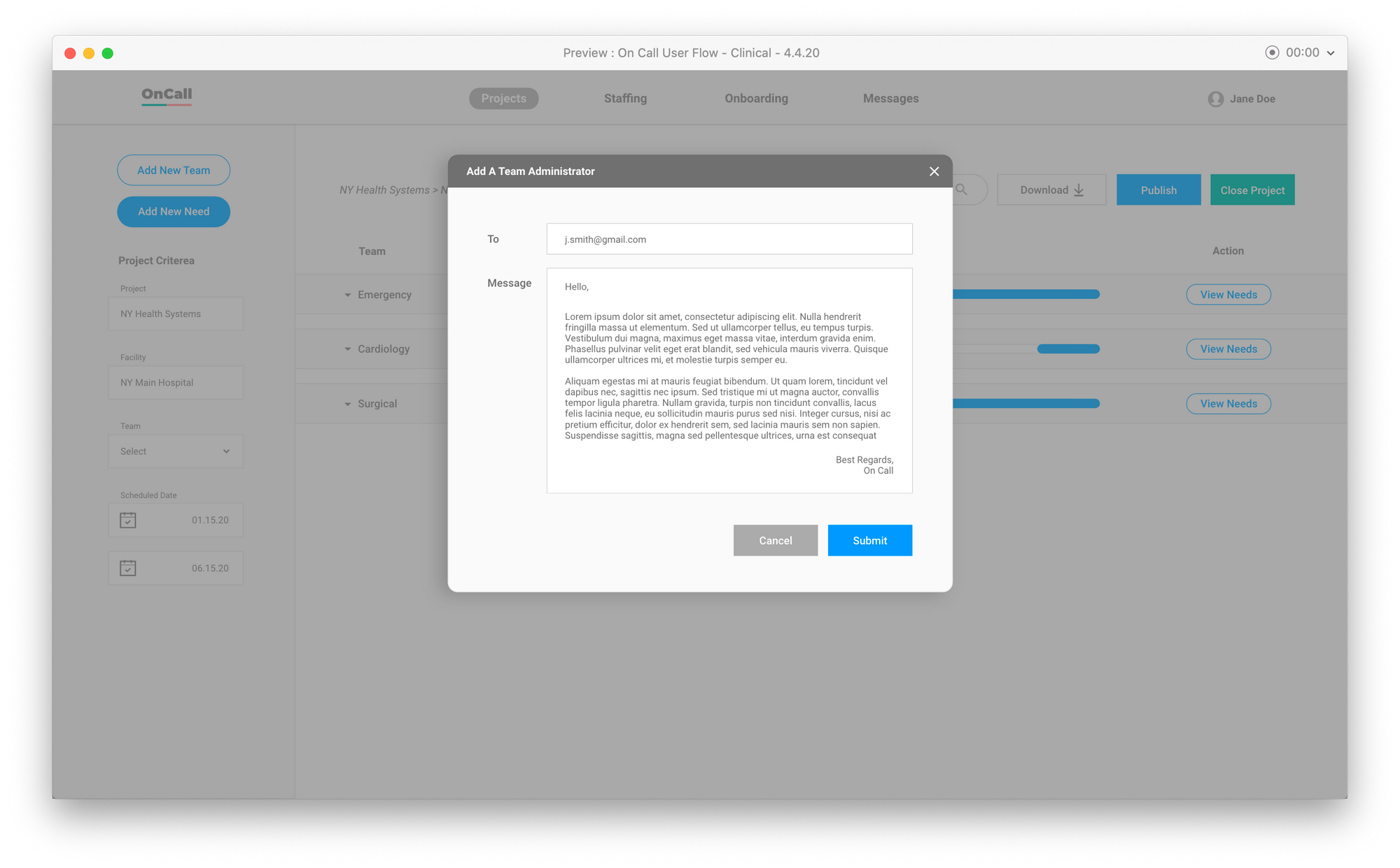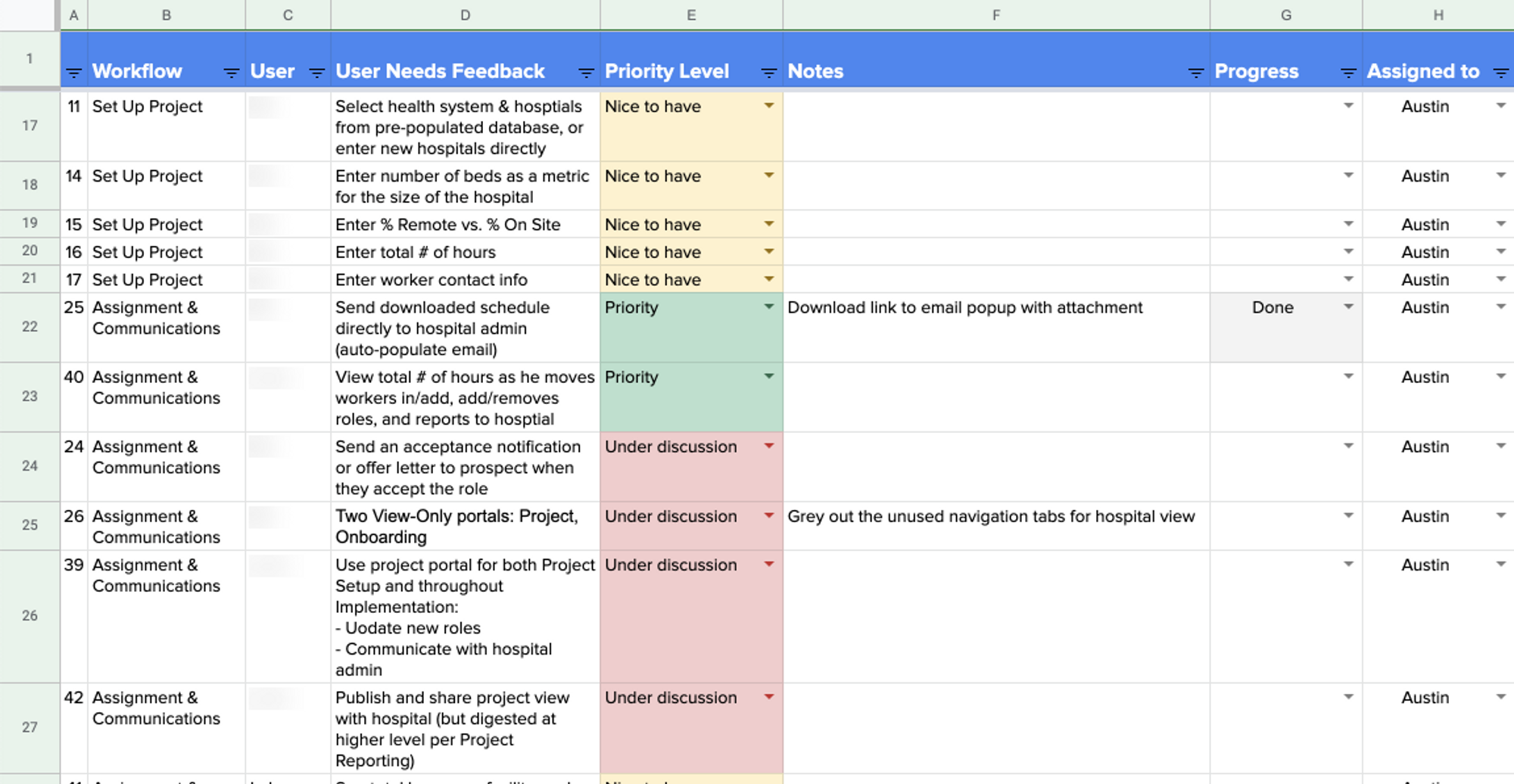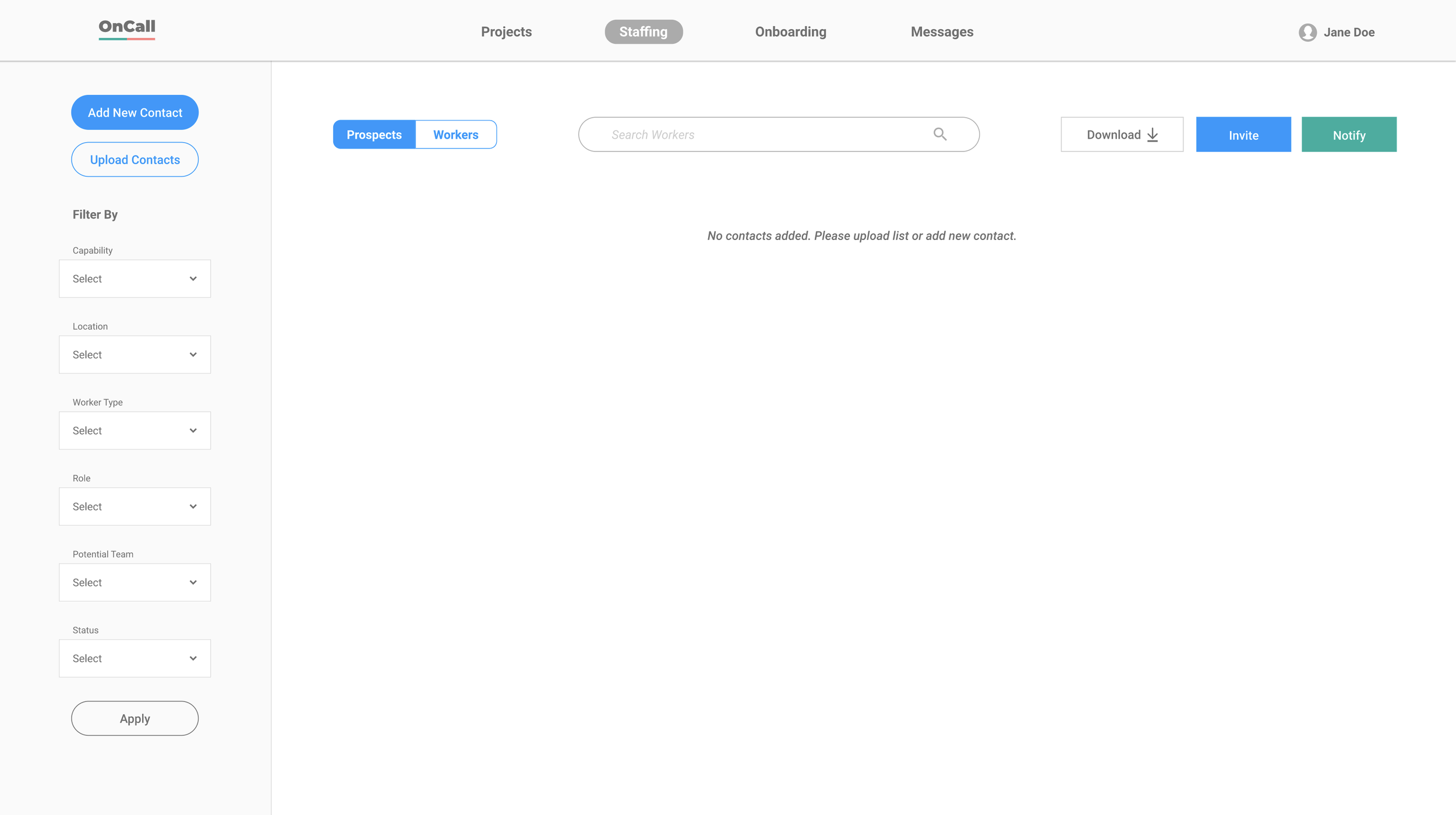ON CALL
B2B Collaborative Healthcare Staffing
On Call helps hospitals hire contract workers collaboratively and efficiently.
OVERVIEW
The Challenge
Our team’s goal was to validate and prototype a flex worker hiring platform that could serve 2 types of clients:
IT Service Agencies
Need to hire 20 to 2,000 qualified IT trainers in as few as 3 weeks for hospital clients.
Hospitals
Often have to fill unexpected staffing shortages quickly.
The Solution
On Call helps hospitals and IT agencies maintain a database of trusted, in-network contract workers.
Centralized place to post open shifts
Workers can easily view & accept shifts
Database of in-network flex workers
Track staffing needs across departments
Summary
4
Designers
10
Weeks
My role
Research Synthesis, Personas, User Journeys, User Flows, Wireframing, Value Proposition Slide Deck
Tools
Adobe XD, Figma, Otter.ai, Google Suite, Whimsical
Results
Validated a hospital use case for the product via user research
Influenced the MVP design to scale for potential hospital clients
Contributions
I simplified the user flow for assigning a worker to a shift
I recruited interviewees (nurses, unit managers, and staffing administrators) who gave key insights about the problem space.
RESEARCH
Summary
Our research objective was to validate if On Call's product concept could be applied to hiring contract workers in a hospital context.
7 User Interviews
2 Nurses
4 Unit Managers
1 Staffing Administrator
User Questions
How does staffing work in hospitals?
Do hospitals commonly use contract workers?
Who are the stakeholders involved in staffing?
Are there pain points in the current staffing process?
Research Process
Our project coincided with the COVID-19 lockdown in NYC and it was difficult to recruit hospital workers for user interviews. We relied on personal networks to connect with 4 Unit Managers and 2 Nurses.
Unit Managers create monthly staff schedules for their unit. They work closely with the Staffing Department to fill any unexpected staffing shortages.
To better understand the administrative staff of hospital staffing, we recruited a hospital Staffing Department employee through LinkedIn.
DEFINE
Staffing Efficiency
Efficient hospital staffing is essential to ensure units are properly staffed to meet patient needs, according to mandated patient-to-staff ratios.
However, hospitals face frequent staffing shortages due to:
Last-minute staff callouts
Surges in patients
Shifts that are hard to fill
It is often challenging to fill staffing shortages quickly because there are many stakeholders and workers who have to communicate rapidly.
Stakeholders
Unit Managers and Staffing Administrators are the main stakeholders in the staffing process. They also coordinate with higher supervisors, who make staff allocation and budget decisions.
Unit Manager
Schedule Full-time Staff
Manage the unit’s budget
Staffing Admin
Recruits Full-time Staff and Flex Workers
Payroll
Staffing Supervisor
Decides which units to allocate Float Staff
Workers
Flex workers in-network can be less expensive than full-time employees (FTEs) working overtime. Unit Managers trust FTEs more, especially in critical care units, e.g. ICU, surgical.
Full-time Staff ($$$)
Employed full-time | Always works in the same unit
Overtime Pay (time and a half)
Flex Workers ($$)
Agency contractors or in-network employees
Premium Pay ( < Overtime) for in-network employees
Agency Pay (Varies) for agency contractors
Float Staff ($)
Employed full-time
Works in different units as needed
Regular pay when assigned to other unit
User Journey
Clinical Staffing Journey Map
User Flow
While IT agencies typically have one Project Manager hiring flex workers, hospitals have multiple stakeholders who own different parts of the hiring process. We created a user flow to show how key hosptial stakeholders would work together in On Call to decide how to fill open shifts and staffing shortages.
DESIGN
Supporting Hospital Users
We needed to translate On Call's existing features to support communication between multiple stakeholders. Our primary clients, IT Agencies, typically have one Project Manager managing all the hiring. Whereas, hospitals have many stakeholders who manage different parts of the process.
Wireframes
The UI Team had designed a high-fidelity prototype for testing with IT Agency users. We would typically start with low- to mid-fidelity wireframes for testing, but due to our tight timeline, we adapted the hi-fidelity prototype for the hospital user flow.
Custom Dashboards
Unit Managers
Unit Manager dashboard shows only their unit
Unit Managers see when shifts are filled
Staffing Admins
Staffing admin’s dashboard shows staffing needs across all hospital units
Staffing admins see when shifts are filled
Unit Managers
I prototyped the experience for the Unit Manager. I realized Managers would need to be able to select qualified workers from the dashboard page, since they do not have access to the full worker database like Staffing.
Submit staffing needs from a centralized place
Request trusted workers who they have worked with before
Staffing Administrators
View staffing needs across different units in one place
Supervisor can directly assign Float workers
Send mass emails to workers about open shifts
Workers
View and sign up for open shifts more easily from one centralized dashboard
TESTING
Prototype feedback and user insights
We wanted to test if On Call's workflow and features support the hospital staffing process. Recruiting for user testing was even more difficult than before as hospitals were still overwhelmed. Fortunately, we had 2 testers to offer the perspective of our 2 key personas: 1 Unit Manager and 1 Staffing Administrator.
Validated Features
Easier cross-collaboration between Unit Managers and Staffing.
Workers can choose shifts more easily. Text alerts are hard to sort through.
Able to confirm shifts for payroll after a flex worker completes a shift.
New Stakeholder – Surge Manager
The Surge Manager has priority to assign Float Staff to critical units. They need their own dashboard to assign Float Staff only.
Uncovered Issues
Staffing manages all worker outreach. Managers should not have this capability.
Overtime approval must be documented.
Need to remind contract workers about shifts. Many often forget to show up or cancel.
Feature Prioritization
We ultimately prioritized design iterations for IT Agency users in the MVP because we had potential IT Agency clients waiting to pilot our platform.
RESULTS
Final design iterations and impact
Results
We validated that hospitals are a potential secondary market for On Call, which makes the product more scalable
Handed off an MVP with validated features and workflow for development
On Call landed its first hospital client at the end of last year
Lessons Learned
In order to be more agile, product testing and validation can happen in stages. We focused on validating the general workflow first, before further testing and iterating on the UI.
Learning to advocate for the user experience within business constraints. In our case, developing and piloting an MVP with a more immediate client became the priority.
Minimum Viable Product (MVP)
I created a business pitch deck showcasing the key solutions of On Call:





